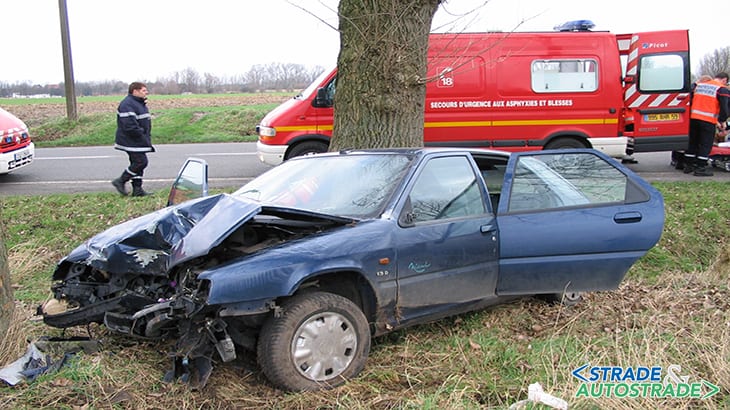![]() Driver assistance systems – Per la versione in Italiano: https://www.stradeeautostrade.it/segnaletica-e-sicurezza/nuove-tecnologie-per-i-sistemi-avanzati-di-assistenza-alla-guida/
Driver assistance systems – Per la versione in Italiano: https://www.stradeeautostrade.it/segnaletica-e-sicurezza/nuove-tecnologie-per-i-sistemi-avanzati-di-assistenza-alla-guida/
For background picture, photo credit: www.clubalfa.it
After a few years of steady decrease in road accidents and fatalities, last year saw a sudden increase in many european countries, up to some paradoxes – as in Belgium – with a decrease in the number of accidents but an increase in the number of victims. In any event, the current rate of reduction will not achieve the objectives set by the Commission.
Advanced Driver Assistance Systems (ADAS) have certainly contributed to the reduction of accidents and, as a result, the Commission and the European Parliament have approved Regulation 2019/2144 which will make some of these systems mandatory on vehicles; in particular the Intelligent Speed Assistant (ISA) and the Advanced Emergency Braking Assistant (AEB). These systems will be mandatory on the new models in 2022, while by 2024 must be installed on all vehicles sold as new.
The european vehicle fleet is over ten years of age: so it will be ten years before most vehicles are equipped with these systems.
The study in question first proposes an assessment of the technical possibility of a retrofit of ADAS, focusing on those made mandatory by the Community Regulation and the eCall system (retrofit means the action of adding new technologies or functionalities to an old system, extending its life). The report shall then describe the benefits to road safety and the assessment of the potential benefits of installing these systems.

The main technical problems regarding the technical feasibility of installing ADAS include the restriction of access to vehicle resources implemented by many manufacturers. For reasons of responsibility and data security, car brands rarely allow access to the electronic systems of their vehicles.
For this reason, the report takes into account only those systems that warn the driver and not those that automatically correct an anomaly. It should be noted that there are technologies which would already allow automatic corrections, but are not currently being used.
In addition to the above two ADAS (ISA and AEB), the report has studied the following assistance systems:
- FCW: collision warning device on the front of the vehicle, both with other vehicles and with pedestrians and cyclists;
- LDW: lane exit signal;
- SLI: information on speed limits;
- DDR-ADR: driver inattention detection;
- REV: hazard warning device at the rear of the vehicle;
- TPM: tyre pressure monitoring system;
- VIS-DET: signalling of pedestrians and cyclists close to the vehicle, including sides of the vehicle;
- 112 eCall: automatic emergency call in case of an accident.
It is noted that the first three devices (FCW, LDW and SLI) are often grouped into one system.
An independent laboratory has been commissioned to carry out tests on these devices, assuming that a properly installed device has the same performance both in the laboratory and on the road, as assured by the manufacturers.
Estimates have also been made on the basis of the existing fleet and its future development to determine the rate of vehicles equipped with ADAS systems.

There is no doubt that, thanks to the new Community Regulation, the percentage of vehicles equipped with such systems will increase in the coming years. But without other voluntary or mandatory measures, the number of equipped vehicles will remain limited and will only have a relative impact on road safety.
The Commission and the Member States must therefore provide for voluntary measures (subsidies, tax advantages, reductions in insurance costs, permission to enter restricted traffic areas and so on) or mandatory measures to implement the use of these drivers’ assistants.
The study has therefore considered different working hypotheses: the first includes voluntary measures such as awareness campaigns and financial incentives: this option provides for an increase of 6-7% per year of vehicles equipped with ADAS systems and an average decrease of 1.6% of deaths. The second option, on the other hand, provides for the obligation to fit the devices on all vehicles running by 2040.
In this case, of course, all vehicles on that date will be equipped with the devices. For the previous period, the average estimate of the decline in deaths is 3.8% per year.
On the basis of documentary studies and existing literature, it has been possible to estimate the effect of ADAS on the number of accidents. It has been established that the most life-saving systems are SLI, LDW, DDR-ADR and 112 eCall.
These devices could prevent, on average, 23% of deaths and 25% of accidents each year, if all vehicles on the road were equipped with them. Finally, the study presents a cost/benefit analysis of the various devices for the class of M vehicles, intended for passenger transport.
However, class N, which is intended for the transport of goods, has not been taken into account and very similar results are expected. The best ratio is presented by the VIS-DET system (signalling of pedestrians and cyclists close to the vehicle).

The SLI system (information on speed limits) is also considered positive. This means that safety benefits outweigh the cost of purchasing, installing and maintaining the device.
This obviously does not mean that other systems are not advantageous in terms of road safety; any system able to prevent an accident or save a life is invaluable and its use should not be conditioned by mere economic issues. The Commission therefore recommends its installation and use and reserves the right to propose further Regulations to increase the number.
![]() Driver assistance systems – Per la versione in Italiano: https://www.stradeeautostrade.it/segnaletica-e-sicurezza/nuove-tecnologie-per-i-sistemi-avanzati-di-assistenza-alla-guida/
Driver assistance systems – Per la versione in Italiano: https://www.stradeeautostrade.it/segnaletica-e-sicurezza/nuove-tecnologie-per-i-sistemi-avanzati-di-assistenza-alla-guida/

